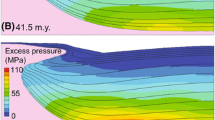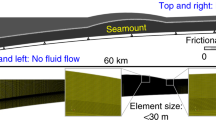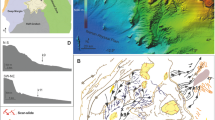Abstract
We use evolutionary poromechanical models to study stress and deformation in sediments that are deposited above a salt sheet, then are upturned in front of salt and eventually buried below salt. Sediments in our model represent rocks that are able to deform plastically. We find that high differential stresses develop, leading to shear failure of sediments as they are upturned in front of salt. However, we show that strength and failure evolve together with the salt system because the mode of loading from the advancing salt changes as sediments fold below salt. We also show that the path of salt flow is affected by the continuous changes in sediment strength. We discuss how the present-day geometry of the salt base may provide evidence of the level of shear below salt. We show that our forward modeling approach can help evaluate mechanical trap integrity by identifying areas that experienced elevated shear during earlier stages of the evolutionary process. Overall, our poromechanical models allow us to correlate kinematics of salt emplacement with the stress history of sediments and identify potential drilling hazards.







Similar content being viewed by others
References
Albertz M, Beaumont C (2010) An investigation of salt tectonic structural styles in the Scotian Basin, offshore Atlantic Canada: 2. Comparison of observations with geometrically complex numerical models. Tectonics 29:TC4018. https://doi.org/10.1029/2009tc002540
Baud RD, Haglund JL (1996) Enhanced subsalt exploration utilizing the basal salt shear model. Gulf Coast Assoc Geol Soc Trans 46:9–14
Crook AJL, Willson SM, Yu JG, Owen DRJ (2006) Predictive modelling of structure evolution in sandbox experiments. J Struct Geol 28:729–744. https://doi.org/10.1016/j.jsg.2006.02.0020
Crook AJL, Obradors-Prats J, Somer D, Peric D, Lovely P, Kacewicz M (2018) Towards an integrated restoration/forward geomechanical modelling workflow for basin evolution prediction. Oil Gas Sci Technol Rev IFP Energies Nouvelles 73:18
Dooley TP, Hudec MR, Jackson MPA (2012) The structure and evolution of sutures in allochthonous salt. AAPG Bulletin 96:1045–1070. https://doi.org/10.1306/09231111036
Dusseault MB, Maury V, Sanfilippo F, Santarelli FJ (2004) Drilling around salt: risks, stresses, and uncertainties. Paper presented at the US Rock Mechanics and Geomechanics Symposium, Houston, TX, 5–9 June 2004 paper 04-647
Flemings PB, Saffer DM (2018) Pressure and stress prediction in the Nankai accretionary prism: a critical state soil mechanics porosity-based approach. J Geophys Res Solid Earth 123:1089–1115. https://doi.org/10.1002/2017JB015025
Fredrich JT, Fossum AF, Hickman RJ (2007) Mineralogy of deepwater Gulf of Mexico salt formations and implications for constitutive behavior. J Petrol Sci Eng 57:354–374. https://doi.org/10.1016/j.petrol.2006.11.006
Gao B, Flemings PB, Nikolinakou MA, Saffer DM, Heidari M (2018) Mechanics of fold-and-thrust belts based on geomechanical modeling. J Geophys Res Solid Earth 123:4454–4474. https://doi.org/10.1029/2018JB015434
Harrison HL, Patton B (1995) Translation of salt sheets by basal shear. In: Travis CJ, Harrison H, Hudec MR, Vendeville BC, Peel FJ, Perkins BE (eds) Salt, sediment and hydrocarbons: 16th Annual Research Conference, Gulf Coast Section; SEPM Foundation, 1995. pp 99–107
Harrison H, Kuhmichel L, Heppard P, Milkov AV, Turner JC, Greeley D (2004) Base of salt structure and stratigraphy—data and models from Pompano field, VK 989/990, Gulf of Mexico. Salt-sediment interactions and hydrocarbon prospectivity concepts, prospectivity: concepts, applications, and case studies for the 21st century. GCSSEPM Foundation, Houston, pp 243–270
Hart W, Jaminski J, Albertin M (2004) Recognition and exploration significance of supra-salt stratal carapaces. In: Post P, Olson D, Lyons K, Palmes S, Harrison P, Rosen N (eds) Salt-sediment interactions and hydrocarbon prospectivity: concepts, applications and case studies for the 21st century. 24th Annual Gulf Coast Section of the Society of Economic Paleontologists and Mineralogists Foundation Bob F. Perkins Research Conference, 2004. Pp 166–199
Hearon TE IV, Rowan MG, Giles KA, Kernen RA, Gannaway CE, Lawton TF, Fiduk JC (2015) Allochthonous salt initiation and advance in the northern Flinders and eastern Willouran ranges, South Australia: using outcrops to test subsurface-based models from the northern Gulf of Mexico. AAPG Bull 99:293–331. https://doi.org/10.1306/08111414022
House WM, Pritchett JA (1995) Fluid migration and formation pressures associated with allochthonous salt sheets in the northern Gulf of Mexico. In: Salt, sediment and hydrocarbons; Gulf Coast Section SEPM Foundation Sixteenth Annual Research Conference, 1995. pp 121–124
Huber WF (1989) Ewing Bank thrust fault zone Gulf of Mexico and its relationship to salt sill emplacement. In: 10th Annual Research Conference, Gulf Coast Section, SEPM Foundation, 1989. pp 60–65
Hudec MR, Jackson MPA (2006) Advance of allochthonous salt sheets in passive margins and orogens. Am Asso Petrol Geol Bull 90:1535–1564. https://doi.org/10.1306/05080605143
Hudec MR, Jackson MPA (2009) Interaction between spreading salt canopies and their peripheral thrust systems. J Struct Geol 31:1114–1129. https://doi.org/10.1016/j.jsg.2009.06.005
Israel RR, Ambrosio P, Leavitt AD, Shaughnessy JM, Sanclemente JF (2008) Challenges of directional drilling through salt in deepwater Gulf of Mexico. Paper presented at the 2008 IADC/SPE Drilling Conference, Orlando, FL, 4–6 March
Jackson MPA, Hudec MR (2017) Principles and practice of salt tectonics. Cambridge University Press, Cambridge, p 510p
McGuinness DB, Hossack JR (1993) The development of allochthonous salt sheets as controlled by the rates of extension, sedimentation, and salt supply. Paper presented at the 14th Annual Research Conference, Gulf Coast Section, SEPM Foundation: Rates of Geologic Process, Dec. 5–8
Muir Wood D (1990) Soil behaviour and critical state soil mechanics. Cambridge University Press, Cambridge, p 462p
Munson DE (1997) Constitutive model of creep in rock salt applied to underground room closure. Int J Rock Mech Min Sci 34:233–247. https://doi.org/10.1016/S0148-9062(96)00047-2
Munson DE, Dawson PR (1979) Constitutive model for the low temperature creep of salt (with application to WIPP). SAND79-1853 Sandia National Laboratories. Albuquerque, NM
Nikolinakou MA, Flemings PB, Heidari M, Hudec MR (2018a) Stress and pore pressure in mudrocks bounding salt systems. Rock Mech Rock Eng. https://doi.org/10.1007/s00603-018-1540-z
Nikolinakou MA, Heidari M, Flemings PB, Hudec MR (2018b) Geomechanical modeling of pore pressure in evolving salt systems. Mar Pet Geol 93:272–286. https://doi.org/10.1016/j.marpetgeo.2018.03.013
Nygard R, Gutierrez M, Gautam R, Hoeg K (2004) Compaction behavior of argillaceous sediments as function of diagenesis. Mar Pet Geol 21:349–362. https://doi.org/10.1016/j.marpetgeo.2004.01.002
Nygard R, Gutierrez M, Bratli RK, Hoeg K (2006) Brittle-ductile transition, shear failure and leakage in shales and mudrocks. Mar Pet Geol 23:201–212. https://doi.org/10.1016/j.marpetgeo.2005.10.001
O’Brien J, Lerche I (1994) Understanding subsalt overpressure may reduce drilling risks. Oil Gas J 92:28–34
Orlic B, Wassing BBT (2013) A study of stress change and fault slip in producing gas reservoirs overlain by elastic and viscoelastic caprocks. Rock Mech Rock Eng 46:421–435. https://doi.org/10.1007/s00603-012-0347-6
Perez MA, Clyde R, D’Ambrosio P, Israel R, Leavitt T, Nutt L, Johnson C, Williamson D (2008) Meeting the subsalt challenge. Oilfield Rev 20:32–45
Perić D, Crook AJL (2004) Computational strategies for predictive geology with reference to salt tectonics. Comput Methods Appl Mech Eng 193:5195–5222. https://doi.org/10.1016/j.cma.2004.01.037
Rockfield (2017) ELFEN forward modeling user manual. Rockfield Software Limited, Swansea
Roscoe K, Burland J (1968) On the generalized stress-strain behaviour of “wet” clay. In: Heyman J (ed) Engineering plasticity. Cambridge University Press, Cambridge, pp 535–609
Rowan MG, Ratliff RA, Trudgill BD, Duarte JB (2001) Emplacement and evolution of the mahogany salt body, Central Louisiana Outer Shelf, Northern Gulf of Mexico. AAPG Bull 85:947–969. https://doi.org/10.1306/8626CA37-173B-11D7-8645000102C1865D
Rowan MG, Giles KA, Hearon TE, Fiduk JC (2016) Megaflaps adjacent to salt diapirs. AAPG Bull 100:1723–1747. https://doi.org/10.1306/05241616009
Saleh S, Williams KE, Rizvi A (2013) Rubble zone below salt: identification and best drilling practices; SPE-166115-MS
Thornton DA, Roberts DT, Crook AJL, Yu JG (2011) Regional scale salt tectonics modelling: bench-scale validation and extension to field-scale predictions. In: Beyond balanced sections: Geological Society of America Conference, Minneapolis, MN, 2011
Urai JL, Spiers CJ (2007) The effect of grain boundary water on deformation mechanisms and rheology of rocksalt during long-term deformation. In: Wallner M, Lux K, Minkley W, Hardy H (eds) 6th conference on the mechanical behavior of salt, ‘SaltMech6’, Hannover, Germany, 22–25 May 2007. Taylor and Francis
van-der-Zee W, Ozan C, Brudy M, Holland M (2011) 3D geomechanical modeling of complex salt structures. In: SIMULIA Customer Conference, 2011
Wang HF (2017) Theory of linear poroelasticity with applications to geomechanics and hydrogeology. Princeton University Press, Princeton
Willson SM, Edwards S, Heppard PD, Li X, Coltrin G, Chester DK, Harrison HL, Cocales BW (2003) Wellbore stability challenges in the deep water, Gulf of Mexico: case history examples from the Pompano field. Paper presented at the SPE Annual Technical Conference and Exhibition, Denver, CO, 5–8 October SPE 84266
York PL, Prichard DM, Dodson JK, Dodson T, Rosenberg SM, Gala D, Utama B (2009) Eliminating non-productive time associated with drilling through trouble zones. Paper presented at the Offshore Technology Conference, Houston, TX, OTC 20220
Zhang J (2013) Effective stress, porosity, velocity and abnormal pore pressure prediction accounting for compaction disequilibrium and unloading. Mar Pet Geol 45:2–11. https://doi.org/10.1016/j.marpetgeo.2013.04.007
Acknowledgements
We would like to thank our anonymous reviewer for their very insightful suggestions. The project was funded by the Applied Geodynamics Laboratory consortium (AGL) and the GeoFluids consortium at The University of Texas at Austin (UT GeoFluids). AGL is supported by the following companies: Anadarko, Aramco Services, BHP Billiton, BP, CGG, Chevron, Condor, Ecopetrol, EMGS, ENI, Equinor, ExxonMobil, Hess, ION/GXT, Midland Valley Exploration, Murphy, Nexen Energy, Noble, Petrobras, Petronas, PGS, Repsol, Rockfield, Shell, SpectrumGeo, Talos Energy, TGS, Total, WesternGeco, Woodside. UT GeoFluids is supported by the following companies: Anadarko, BHP Billiton, BP, Chevron, Conoco-Phillips, ExxonMobil, Hess, Pemex, Repsol, Shell, and Equinor. The authors received additional support from the Jackson School of Geosciences at The University of Texas at Austin.
Author information
Authors and Affiliations
Corresponding author
Ethics declarations
Conflict of interest
Maria A. Nikolinakou, Mahdi Heidari and Michael R. Hudec have received research funds from member companies of the Applied Geodynamics Laboratory consortium (Anadarko, Aramco Services, BHP Billiton, BP, CGG, Chevron, Condor, Ecopetrol, EMGS, ENI, Equinor, ExxonMobil, Hess, ION/GXT, Midland Valley Exploration, Murphy, Nexen Energy, Noble, Petrobras, Petronas, PGS, Repsol, Rockfield, Shell, SpectrumGeo, Talos Energy, TGS, Total, WesternGeco, Woodside). Maria A. Nikolinakou, Mahdi Heidari and Peter B. Flemings have received research funds from the GeoFluids consortium (Anadarko, BHP Billiton, BP, Chevron, Conoco-Phillips, ExxonMobil, Hess, Pemex, Repsol, Shell, and Equinor). Maria A Nikolinakou is a member of the Executive Committee of ARMA.
Additional information
Publisher's Note
Springer Nature remains neutral with regard to jurisdictional claims in published maps and institutional affiliations.
Appendices
Appendix 1
See Fig. 8.
Appendix 2
See Figs. 9 and 10, Tables 1 and 2.
Basic principles of critical state model SR3 [schematic after Gao et al. (2018)], plotted using material input for present study (Table 2). a Mean effective stress (σ′m) vs. deviatoric stress (q) space. Yield surface (gray) evolves with increase in preconsolidation stress. Critical state line (red) defines the maximum deviatoric (shear) stress, qf, that the material can support for a given mean effective stress. The ratio of shear to mean effective stress ( η = q/σ′m) is constant along the uniaxial compression path (dashed black line) as well as the critical state line. Iso-porosity curves (green, purple and cyan) represent all combinations of mean effective stress and shear stress that compress to a given value of porosity. b Mean effective stress (σ′m) vs. porosity (n). Increasing the shear ratio (η) from uniaxial (black curve) to critical state (red curve) leads to lower porosity for the same mean effective stress. A curved iso-porosity line in a (e.g., n = 0.23, purple curve) corresponds to a horizontal line in b (purple line at n = 0.23). As the shear stress ratio increases from uniaxial to critical state, the mean effective stress decreases, illustrating the role of shear-induced compression and the interrelation between mean effective stress, shear stress and porosity (color figure online)
Appendix 3
Rights and permissions
About this article
Cite this article
Nikolinakou, M.A., Heidari, M., Hudec, M.R. et al. Stress and Deformation in Plastic Mudrocks Overturning in Front of Advancing Salt Sheets; Implications for System Kinematics and Drilling. Rock Mech Rock Eng 52, 5181–5194 (2019). https://doi.org/10.1007/s00603-019-01852-2
Received:
Accepted:
Published:
Issue Date:
DOI: https://doi.org/10.1007/s00603-019-01852-2







